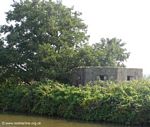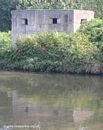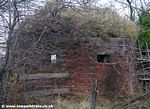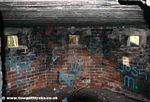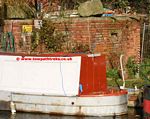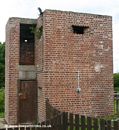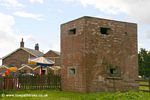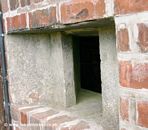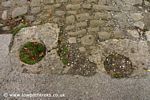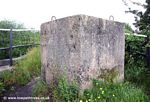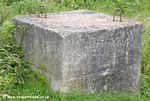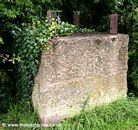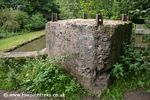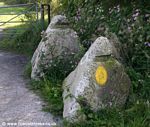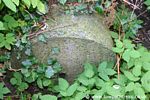Maghull to Burscough
12- 24 miles
Burscough
to Wigan
24 - 34 miles
Former Lancaster
Canal South
37-47miles
Johnson's Hillock
to Cherry Tree
47 - 54 miles
The Leeds & Liverpool Canal at War
World War Two
In 1940 Britain fled France leaving her French allies to fight on alone. The British Expeditionary Force left their arms, ammunition, equipment and vehicles behind at Dunkirk to fall into the hands of the Nazis. The German Army was on the beaches of France looking across the Channel to England.
Invasion was with hindsight unlikely. An invasion of Britain was never a priority for Hitler who expected Churchill to deal once the British were defeated in Europe. Hitler knew little about amphibious warfare thinking that crossing the channel would be like crossing the rivers of Europe. With Churchill defiant however Hitler amassed an armada of flat bottomed river barges from all over Europe to carry the German army across to England. Such a crossing would have been doomed to fail. The Royal Navy would easily sink any cross channel expedition. A RN Battleship sailing through a convoy of river barges would have had a devastating effect. If any Germans did manage to land they would have been without reinforcements and re-supply and battered by the Navy's guns and faced with the army onshore.
But at the time Britain felt vulnerable. It had very low levels of ammunition, weapons, and vehicles. Supplies were so low that troops couldn't practice firing artillery.
The south coast was the obvious location for invasion but there was also speculation that Germany could attack from the Republic of Ireland or via the Irish Sea at the North West coast. As well as amphibious assault there was the threat from the air. It was said that Germany could move 10,000 troops by air in a similar operation to the Allied's Operation Market Garden later on in the war. The origins of the Home Guard lay in the 'parashots' who would patrol looking for German paratroopers who may or may not have been dressed as nuns.
The Threat of Invasion and the Canal Stop Lines
Lancashire has a coastline with flat beaches ideal for amphibious landings. Inland from the coast is the Lancashire plain, flat agricultural land which would be a good landing zone for paratroopers or for gliders and transport planes to crash land. To defend against this a defensive "Stop Line" was built. The Western Command Stop Line Number 14 extended from Wigan to Liverpool and was based around the Leeds Liverpool Canal. Stop Lines were based on anti-tank ditches and pill boxes. Their aim was to slow down the enemy's advance and to allow counter attack. Villages would be defended to become islands of resistance. The canal and its embankment would act as the anti-tank ditch. Concrete pill boxes and fortified buildings were places at bridges and at points with good views over the fields below. The stop lines were designed to combat light tanks and infantry not the Panzers and blizkrieg that the Nazis used so efficiently in Europe. The defences were built quickly, some are based on official designs others unique to their location.
Map of the Defences
if you are using Chrome the symbols will take a while to load not my fault.
View World War Two Defences Lancashire in a larger map
Pill Boxes on the Leeds & Liverpool Canal
There were 6 template designs for pill boxes, Type 22 to Type 27. The pill boxes built around the country, 28,000 of them, were based on these designs. The pill boxes I have found are Type 22 hexagonal pill boxes with loopholes for rifles in five of the six sides. They are reinforced concrete with walls 30-40cm thick.
Block Houses on the canal
These brick built two storey towers or block houses are four sided with one loophole on each side on each floor. These embrasures are wider on the outside than on the inside. They are either pre-cast concrete or concrete slabs, or just brick. At Heaton's Bridge and Melling they stand alone and have flat roofs. At the Farmers Arms the tower is part of the pub buildings with a roof of its own, this would be to disguise it.
The second floor of the tower would give good views of the surrounding countryside and a different range of fire to the lower level. They are said to be look out posts for U-Boats coming up the canal!
Fortified Buildings
In many cases existing buildings close to bridges were fortified. Pre-cast embrasures were added to barns and outbuildings. This would have been a quick way to add defences with the minimum of resources used.
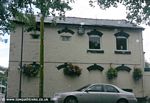 |
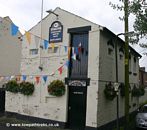 |
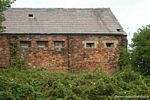 |
 |
| Fortified Barn by the Slipway Pub | Fortifield Barn next to The Slipway | Fortified Barn next to Downholland Bridge #20A | Bricked up loopholes in a wall on the canal bank in Maghull |
Roadblocks
Bridges would have had roadblocks. They would have been either fixed with large concrete blocks or moveable with barbed wire.
The Blitz
Liverpool was hit hard by German bombers on the nights of the 20th 21st and 22nd of December 1940. 622 people were killed and 777 injured. On the night of the 20th a delayed action bomb burst on the banks of the canal between Bankhall Bridge and Athol Street. The canal was breached and flooded into a railway yard. Three barges were wrecked in the large crater in the dry bed of the canal, others reared up against the banks, one was washed through to the rail yard. (link to photo) The draining of the canal meant there was a shortage of water for putting out fires.
There was a large hole in Bankhall Bridge which meant buses and trams couldn't pass over it causing travel chaos. (photo pp.88 Merseyside's Secret Blitz Diary)
Each night during the Blitz stop planks were put in at bridges and other narrow points in the canal to reduce the amount of water lost if the canal was breached by bombs. At Gorsey's Lane Bridge a wharf was used to store goods away from the city centre and dock.
The canal company head office at Pall Mall were bombed in 1941 and the company moved its paperwork etc to a private house, Woodford, at Barkfield Avenue, Formby while operations continued to be controlled from Eanam in Blackburn. Ribble was damaged by enemy action at the time.
Memorial to HZ251
 On 23 September 1943 a Wellington bomber, HZ251, and its Polish crew crashed into the bank of the Leeds Liverpool Canal near Bridge #183. All seven members of the crew were killed. This memorial was unveiled on 22 April 2007
On 23 September 1943 a Wellington bomber, HZ251, and its Polish crew crashed into the bank of the Leeds Liverpool Canal near Bridge #183. All seven members of the crew were killed. This memorial was unveiled on 22 April 2007
Ollerton Bridge Number 2
During World War Two the War Office Training Wing held a battle course here for Home Guard units. There was machine gun fire and the Home Guard had to run over a set course. The end of the course saw the troops run over Ollerton Bridge Number 2. As the troops ran over a canister bomb was thrown into the canal by the trainers to give an explosive ending to the run. As it happened the first three groups ran over the bridge without the explosion. As the fourth group ran over their bomb set off the previous three and a huge column of water erupted from the canal. The men were half drowned and the canal bank was breached. The War Office had to pay for the repairs.
Burscough Airfield: HMS Ringtail
A Royal Navy Fleet Air Arm base which had four runways and dispersed hangers and buildings.
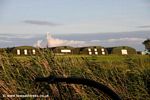 |
 |
||
Wartime Canal Workers
Canals remained in use throughout the Second World War. Canal companies like Canal Transport Ltd on the Leeds & Liverpool Canal lost a lot of their workforce in the early stages of the war. Wartime factories could offer higher wages than canal companies and railways were hiring hundreds of men. Canals already had a bad reputation for poor pay and conditions and couldn't compete for workers. Canal Transport Ltd were forced to rent out boats to other companies and had nine tied up unworking. As the war went on the younger boatmen were called up into service. Working conditions were so bad that in November 1941 the boatmen went on strike for a week. Soldiers from the Inland Water Transport Section were used on the Leeds - Liverpool Canal in 1941.
The Canals were under government control from 1942 and it was the government that had to find workers for the canal. Irish men were brought over to work on the canals but most of them decided that there was more money to be made elsewhere. By 1943 there was still a shortage of men on the canals. Women were trained to work on the boats but work on wide Leeds Liverpool Canal was thought to be too arduous for women.
Websites
-
www.worldwar2defences.co.uk A very good website with an interactive map showing the sites of WW2 defences in Merseyside and Lancashire
-
www.pillbox-study-group.org.uk/stoplinespage.htm Explanation of the stop lines.
-
http://www.britarch.ac.uk/cba/projects/dob/ Defence of Britain Database
Books
Title |
Author |
|
Merseyside's Secret Blitz Diary |
A.Johnson |
2005 |
Lancashire Airfields in the Second World War |
A.P.Ferguson |
2004 |
20th Century Defences in Britain: An Introductory Guide |
Council for British Archaeology |
1995 |
The Home Guard |
S.P.MacKenzie |
1995 |
Bombers over Merseyside |
|
1983 |
The Last Ditch |
D.Lampe |
1968 |
The Ironside Diaries 1937-1940 |
E.Ironside |
1962 |
Operation Sealion |
R.Wheatley |
1958 |
Home Guard for Victory! |
H.Slater |
1941 |
|
|
|
Shipley to Leeds
115 -125 miles
Stockbridge to Shipley
109 -115 miles
Skipton to Stockbridge
99 - 109 miles
Gargrave to Skipton
93 -99 miles
Greenberfield to Gargrave
87 - 93 miles
Foulridge to Greenberfield
82-87 miles















